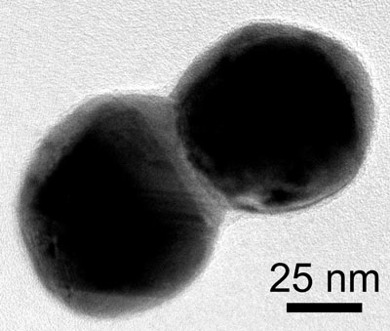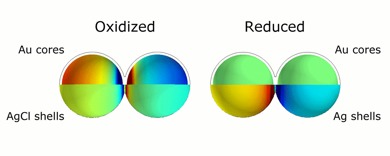Medieval artisans unwittingly used nanotechnology when they mixed gold chloride into molten glass to create richly hued stained glass windows. Soon we could have full-colour displays or stained-glass windows that change colour at the flick of an electrical switch, thanks to the same kinds of light-scattering nanoparticles.
We’re one step closer to such wondrous things with a new method for connecting metal nanoparticles via teensy “drawbridges” of thin layers of silver, developed by researchers at Rice University. This lets them link pairs of nanoparticles that scatter different colours of light together to form simple colour displays. The scientists described their work in a new paper in Science Advances.
Nanoparticles are special because they straddle the boundary between the macroscopic and quantum realms, where classical physics and quantum mechanics hold sway, respectively. It’s their size that matters: a nanometre is one billionth of a metre, and nanoparticles range in size from a few nanometres to several hundred nanometres. That gives them unusual properties not found in the same elements at the macro scale.

This includes optical properties, notably how metal nanoparticles in particular scatter light. Scientists have analysed medieval stained glass windows, and found gold and silver nanoparticles are the key to the deep reds and yellows found therein.
The gold nanoparticles absorb blue and yellow light; red light, with its longer wavelength, reflects off them and passes through the glass. Something similar happens with silver nanoparticles; only bright yellow light scatters off and passes through the glass. Make gold spheres a bit larger, and you can get green or orange. Make the silver nanoparticles smaller, and you get blue.
They have interesting chemically reactive properties, too. In 2008, for instance, scientists at Queensland University of Technology found that some stained glass windows actually helped purify the air when the sun shone through them. The secret ingredient was gold nanoparticles. Sunlight activated the nanoparticles so they could destroy volatile organic chemicals (VOCs) — the source of that new car smell, for instance, but toxic if inhaled in larger quantities.
The properties of medieval stained glass are so unique, Welsh scientists recently used their own versions of the material to build a special 3D panoramic camera for the European Space Agency’s 2019 Mars rover mission. In that case, the useful property was the way the glass resists fading — even after hundreds of years of exposure to the sun’s UV radiation. By blocking UV radiation, the nanoparticles in the stained glass chips will capture the true colours of the red planet.

But it’s proven challenging to induce metal nano particles to switch colours, a critical ability if you want to build a colour display with them. Past work has managed some slight shifts in hue by linking nanoparticles with nanowire bridges. The Rice scientists improved on those techniques to make the colour shifts stronger via a kind of chemical bridge.
First, the Rice team fixed pairs of gold nanoparticles to a glass surface coated with conductive indium tin oxide, or ITO (it’s in your smartphone screen, for instance). They used the ITO to coat the surface of the gold particles with a silver electroplate. Then they immersed them in saltwater electrolyte with a silver electrode to form a circuit. Zap the nanoparticles with a negative voltage, and a conductive silver “drawbridge” forms. Reverse the voltage, and the bridge withdraws.
“The great thing about these chemical bridges is that we can create and eliminate them simply by applying or reversing a voltage,” group leader Christy Landes said in a press release. “This is the first method yet demonstrated to produce dramatic, reversible colour changes for devices built from light-activated nano particles.”
Reference:
Byers, C.P. et al. (2015) “From tunable core-shell nanoparticles to plasmonic drawbridges: Active control of nanoparticle optical properties,” Science Advances 1(11): e1500988.
[Via Nanowerk News]
Images: (top) Stained glass window in 11th century Saint Walburga church, Oudenaarde, Belgium. Credit: skyfish / Shutterstock.com. (middle) Electron microscope image of two silver-plated gold nanoparticles connected by a “drawbridge”: a layer of silver. (bottom) Different colours of light without drawbridges and with them. Credit: C. Byers/Rice University.
